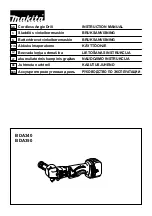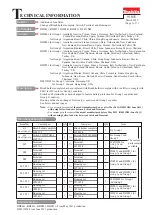
GENERAL SAFETY RULES
n
Do not use the power tool if the switch does not turn
it on and off.
Any power tool that can not be controlled
with the switch is dangerous and must be repaired.
n
Disconnect the plug from the power source and/
or the battery pack from the power tool before
making any adjustments, changing accessories,
or storing power tools.
Such preventive safety
measures reduce the risk of starting the power tool
accidentally.
n
Store idle power tools out of the reach of children
and do not allow persons unfamiliar with the
power tool or these instructions to operate the
power tool.
Power tools are dangerous in the hands
of untrained users.
n
Maintain power tools. Check for misalignment or
binding of moving parts, breakage of parts and
any other condition that may affect the power
tools operation. If damaged, have the power tool
repaired before use.
Many accidents are caused by
poorly maintained power tools.
n
Keep cutting tools sharp and clean.
Properly
maintained cutting tools with sharp cutting edges are
less likely to bind and are easier to control.
n
Use the power tool, accessories and tool bits
etc. in accordance with these instructions, taking
into account the working conditions and the
work to be performed.
Use of the power tool for
operations different from those intended could result
in a hazardous situation.
BATTERY TOOL USE AND CARE
n
Recharge only with the charger specified by the
manufacturer.
A charger that is suitable for one type
of battery pack may create a risk of fire when used
with another battery pack.
n
Use power tools only with specifically designated
battery packs.
Use of any other battery packs may
create a risk of injury and fire.
n
When battery pack is not in use, keep it away
from other metal objects, like paper clips, coins,
keys, nails, screws or other small metal objects,
that can make a connection from one terminal to
another.
Shorting the battery terminals together may
cause burns or a fire.
n
Under abusive conditions, liquid may be ejected
from the battery; avoid contact. If contact
accidentally occurs, flush with water. If liquid
contacts eyes, additionally seek medical help.
Liquid ejected from the battery may cause irritation or
burns.
SERVICE
n
Have your power tool serviced by a qualified repair
person using only identical replacement parts.
This will ensure that the safety of the power tool
is maintained.
CHARGER SAFETY
n
Do not expose charger to wet or damp conditions.
n
Use of an attachment not recommended or sold by
the battery charger manufacturer may result in a risk
of fire, electric shock, or injuries to person.
n
To reduce risk of damage to charger body and
cord, pull by charger plug rather than cord when
disconnecting charger.
n
Make sure cord is located so that it will not be stepped
on, tripped over, or otherwise subjected to damage
and stress.
n
An extension cord should not be used unless
absolutely necessary. Use of improper extension
cord could result in a risk of fire and electric shock. If
extension cord must be used, make sure:
a. That pins on plug of extension cord are the same
number, size and shape as those of plug on charger.
b. That extension cord is properly wired and in good
electrical condition.
n
Do not operate charger with a damaged cord or
plug. If damaged, have it replaced immediately by a
qualified serviceman.
n
Do not operate charger if it has received a sharp
blow, been dropped, or otherwise damaged in any
way; take it to a qualified serviceman.
n
Do not disassemble charger; take it to a qualified
serviceman when service or repair is required.
Incorrect reassembly may result in a risk of electric
shock or fire.
n
To reduce risk of electric shock, unplug the charger
from outlet before attempting any maintenance or
cleaning. Turning off controls will not reduce this risk.
n
Disconnect charger from power supply when not in
use.
n
Risk of electric shock. Do not touch uninsulated
portion of output connector or uninsulated battery
terminal.
n
Save these instructions. Refer to them frequently
and use them to instruct others who may use this
unit. If you loan someone this unit, loan them these
instructions also.
2
961067060-01(B).indd 2
961067060-01(B).indd 2
8/11/08 3:11:28 PM
8/11/08 3:11:28 PM

























